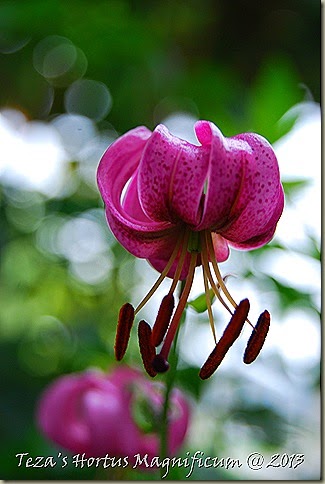The title of this post is not really in reference to the iconic book of the same title, but does indeed allude to a garden that is not at once visible to the eye. One has to get down on bended knee to appreciate the hidden world that exists beneath the apparent beauty of the garden that most people 'see' when they visit Teza's Garden. I am sure that I am not the only gardener who, perhaps because of my penchant for 'layered' plantings, has come to appreciate the various tiers and depths that a garden filled to brimming affords. [Who knows: perhaps this post is a subliminal plea for more adventurous plantaholics to adopt my 'fill it to overflowing' gardening mentality! Stranger things have happened!]
The majority of the plants that make up this post are so well hidden from the unsuspecting eye that at times, I have gone berserk gently lifting aside the foliage of its larger siblings, frantic that I had lost a prized treasure. Luckily for me, these manic episodes usually resolve themselves quite happily and a momentarily 'lost' treasure and I are reunited with one another.
I adore the genus Larix, and when, on a visit to Darren Heimbecker's magnificent Botanical Garden and Nursery, Whistling Gardens, located Brantford way, I stumbled upon Larix kaempferi 'Wolterdingen,' I knew I had to find a spot for him back home. His lush, soft green feathery foliage of a decidedly blue-silver hue is what first caught my eye, but when I learned that he was a true dwarf, it was a done deal. Plant lover/hoarder/collector that I am, space has always been a challenge for me. He now resides to the left of my front veranda, next to/beneath the foliage of Paeonia mlokosewitschii and Polygonatum x hybridum 'Betberg.' Essentially he is totally hidden from view, which, for some would seem like a waste of such a diminutively adorable garden plant, but for me he is a prized treasure that is currently bulking up. Once I am certain that he is going to be happy here at Teza's Garden, I will scout out a more visible location.
The bottom right in this photo tells you that we are in the same small bed where 'Wolterdingen' resides. It is also here where one of two Hepatica species resides. Hepatica transsilvanica 'Buis' which is a European selection native to Romania and Hungary possesses large, one inch blue flowers! It is a more robust species than its cousin 'Blue Jewel,' with fabulous deeply lobed foliage and those flowers! As a Spring bloomer, he really shines, long before the purple infused stems and foliage of 'Betberg' begin their starring role. Competition in this bed alone is frighteningly fierce. A garden with more than one diva can sometimes spell TROUBLE!
'One can never be too rich, too thin, nor have enough Arisaema species in their woodland gardens!' Who knew that Wallace Warfield Simpson was an avid collector of what remains one of my all time favourites! When I discovered a near black leafed selection of our native A.triphyllum, not to mention the stunning A.consanguineum 'Perfect Wave' both on the same visit to LH, well, needless to say that both came home and reside in close proximity to one another in the Border of Botanical Wonders. While A.triphyllum 'Black Jack' is entirely and totally mesmerizing, he has been frustratingly slow to bulk up. Patience is a virtue. This year I was surprised to see a seedling of what might be either A.fargesii or A.candidissimum. I am casting my vote to the latter as it would appear that I have a second, much larger A.candidissimum seedling that has managed to locate himself close to 2m from the parent plant. Of course, if either turn out to be A.fargesii...... fingers crossed!
The Border of Botanical Wonders is home to one of my favourite woodland plants: Saruma henryi - he of the lush purple infused juvenile foliage that matures to a delightful bright green, each leaf shaped like a heart. He is often mistaken for Asarum, and one must admit that his name is suspiciously close in sound and appearance! This year I have a seedling that is quite happily bulking up at the base of my resident Astilboides tabularis. My sublime Asian ginger, Asarum splendens is also happily spreading his joy in close proximity to Astilboides. His spear shaped, heavily mottled foliage adds a tropical essence to the border. I have had second thoughts of moving him to a pot where I can more easily appreciate his truly bizarre looking flowers that appear before his foliage, but have had him here for seven years where, although one has to look closely to spot him, I think he is quite happy.
At the far end of this same border is where Paeonia x 'Going Bananas' resides. Light, clear single yellow flowers appear in early June, and by August all that remains is its stunning foliage, which, in keeping with the theme of this post, tends to obscure the daintier foliage of two of my favourite Epimedium species. Again, as Spring bloomers, both 'Sakura Maru' and 'Tama no Genpei' are both able to bloom long before Miss Bananas foliage has unfurled. A sudden realization comes to me: my current favourite within the genus, Epimedium x 'Windfire' is also 'hidden' by, you guessed it, Mr Astilboides himself!
And last, but certainly not least, on the other side of the house, hidden from view by the overzealous not to mention lax stems of a resident Baptisia, is where Abies concolor 'Blue Cloak' resides. He is one of my latest additions and is supposed to maintain a sublime weeping form, attaining a height of perhaps 3m. This I cannot wait for! And there you have it, the 'secret' garden within a garden. How many other gardeners are in possession of such a delighful anomaly?











































No comments:
Post a Comment